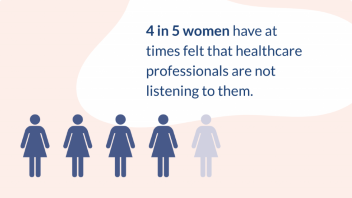
Advocating for the Most Vulnerable in Healthcare
Our doctrine mandates that we care for others. Scripture tells us to love our neighbors, do justice while loving mercy, and be good Samaritans. Many folks have had experiences in healthcare that could have gone better. I know I have. This is not to say that there are no positive vibes at the opposite end of the spectrum because there most certainly are. However, the most vulnerable populations don’t always have equal access to care. This includes the poor, disabled, elderly, children, and women.
The medical model of healthcare, by definition, is supposed to focus on diagnosing and treating disease. This has been the dominant approach in the United States for many years. While this model has led to significant advancements in medical technology and treatment options, it has also been criticized for its limitations in addressing the complex needs of patients, particularly women, children, and the elderly. Sadly, even diagnosing and treating patients sees mistakes and gaps in patient care. These gaps can have devastating consequences.
In recent years, there has been a growing movement to incorporate a more comprehensive approach to healthcare that considers individuals’ physical, emotional, and spiritual well-being. These are steps in the right direction, but the execution at this stage, unfortunately, often misses the mark. Prayer and faith in the healing process and the need for legislative action to improve access to the services needed are paramount if we are going to see real change. The goal, of course, is to improve patient outcomes and said patient outcomes begin with healthcare workers. It makes sense that praying for and showing appreciation and respect to the often overworked professionals in the trenches is a simple first step. In addition to individual prayer and through your church home, you can also check out the National Prayer Breakfast as a way to lift up others as well.
Praying for Healthcare Workers
James 5:16 (NIV) says, “pray for each other so that you may be healed. The prayer of a righteous person is powerful and effective.” Healthcare workers are on the front lines of patient care and often face tremendous challenges in their work. Mind you, we knew this before the COVID-19 pandemic, but arguably, we didn’t appreciate the services provided in the healthcare industry until hospital waiting rooms became standing-room-only venues without enough ventilators to go around. This group deserves prayer and support to be healthy in body, mind, and spirit. This, in turn, allows them to advocate for their most vulnerable patients.
We ought to be praying for all those involved in the healthcare industry, including specialists, phlebotomists, nurses, technicians, administrative, pastoral care, cafeteria, and janitorial staff, to name a few.
Prayers can provide healthcare workers with a sense of peace, comfort, and hope. It can help them connect with something larger than themselves and find meaning in their work. 1 Timothy 2:1 (NIV) reminds us that we should pray for all people.
In addition to praying for healthcare workers, we can also support them by advocating for policies that improve their working conditions and provide them with the resources they need to do their jobs effectively. At the end of the day, they can’t take care of the most vulnerable without the tools to do so.
Legislative Action to Improve Access and Patient Outcome
Many patients, particularly women, children, and the elderly, face significant barriers to accessing needed services. These barriers can include lack of insurance, high costs, and limited availability of providers. The U.S. Department of Human Services defers to state affiliates, however, some services may be accessed through this avenue for those who qualify. For more information on where the medical model stands on the issues, the American Medical Association publishes legislative-related information on its website.
To address these challenges, lawmakers need to enact policies that expand access to affordable healthcare, increase funding for essential services, and improve overall patient outcomes. The best advice for this is to research candidates and vote for people with proven backgrounds in standing up for the most vulnerable. You can look up your representatives on both the United States House of Representatives and United States Senate websites. Legislative action should be as individualized as possible and focused on patient-centered care. Let’s talk about three of those groups: women, pediatrics, and geriatrics.
Advocating for the Most Vulnerable Includes Women

Women face unique health challenges, such as pregnancy, childbirth, and menopause. Lawmakers need to ensure that women have access to comprehensive reproductive healthcare services, including contraception, abortion, and maternity care. I realize it may be unusual to see abortion advocated for through the Christian lens, however, I believe that women should have full access to medical care that meets their needs, period. Advocating for the most vulnerable among us, means ensuring that all women have full access to meeting their health needs. It is not nor should it be up to the church or government to make these choices.
I could do an entire article on specific health-related examples from my personal experiences as a woman. But for the sake of staying on topic and time, my first birth experience was challenging. So, lets talk about that. This kiddo is about to be fifteen years old, but I can remember the details as if it happened five minutes ago. Long story short, my water broke about a month early. Labor didn’t progress, and after seventeen hours and his heart rate briefly dropping, the doctor got him out via C-section.
Competent Care Can Still Be Compassionate.
His muscle tone was noted to be low, he had facial features that caused concern to the attending pediatrician, and while he was eating, he wasn’t eating enough. About twelve hours after his birth, the pediatrician popped in and said, “So, he is kinda loosey-goosey [reference to his muscle tone], and his face has some dysmorphic features. I’m running some tests and put in a call to a colleague [with the nearest children’s hospital]. I’ll get back with you later.” He then walked out, seemingly wiping his hands. The next day, Doc Snarky Pants showed up at 8:00 AM to inform me that the local children’s hospital was sending an ambulance to take our baby to their NICU and begin genetic testing. “And, oh yeah, they will be here to take him in an hour, and no, you can’t go because your OB will need to discharge you.”
I remember being alone after that. My husband followed the transport to care for our baby as best he could. I tried to be proactive and asked for lactation services to help me get started with pumping. As a first-time mom, everyone said breast is best, but I had no clue or instinct on how to feed my baby. They said no, “We have to help the moms whose babies are still here…sorry.” I decided I’d figure out the lactating puzzle later. In the meantime, I had two choices. I could wallow and cry or I could hoist up my hospital-issued mesh underpants and work on convincing my doctor to let me leave. I wallowed a bit; then I started asking to get out of that bed. By the afternoon, I was walking laps around the nurse’s station. My doctor released me the next day.
In this example, my medical needs were met. Our son’s medical needs were met. We both got to come home. This was not a tragedy, and I still praise God every day. However, my mental health was not considered, and neither was my nor my newborn’s need for closeness and bonding. This is one of many examples of how care can be improved and why I think it is so important to encourage advocacy efforts for the most vulnerable.
Advocating for the Most Vulnerable in Pediatrics

Children have special healthcare needs, and it is important to ensure that they have access to quality pediatric care. Lawmakers need to increase funding for children’s health programs to ensure that children have access to preventive care, immunizations, and treatment for chronic conditions. Depending on your state, Medicaid and CHIP can be extremely difficult to access. From a medical provider standpoint, these programs do not pay anywhere near the billing mark in comparison with private insurance. As a result, there are fewer providers to choose from and often red tape to get around for equitable access in testing and treatments.
The other issue for this population is a need for responsive care that allows and values parents as part of the team. Let me give an example. When our youngest baby was six months old, we noticed some sleep and feeding changes that seemed to build up over the course of a couple of weeks. I think I called our pediatrician three to four times, expressing concern. They lectured on sleep training and how babies will go through periods of not eating as much.
The advice had merit. However, I knew something wasn’t quite right and that should have been taken seriously as well. After all, by the time this third baby got here I knew all that already. Fast forward to a Friday in mid-September. He went to bed at 3:00 AM and slept until 1:00 PM. At 4:00 PM he had the first of what would be many seizures. Only, they didn’t look like seizures. I called the pediatrician. The office staff told me they hoped my day got better for me and hung up, not even leaving a message for the doctor or her nurses. I think pediatrics are arguably the most worthy of advocating for the most vulnerable of us.
Delays in Treatment Impact Patient Outcomes
Three days later, he would repeat the behavior in clusters before sleeping. I greeted my husband at the door on Monday when he got home from work. We took him to the ER. Our baby would have these seizures in clusters in front of two nurses, an x-ray technician, and the attending nurse practitioner. The nurse practitioner gave him Tylenol and sent us home. I discuss this experience in depth on my blog, The Midnight Toddler. Long story short, it took a second trip to the emergency department to get our baby help. The sad truth is that many babies have devastating outcomes because of delays in treatment.
Getting to the professional who had the experience necessary to test for, diagnose, and treat Infantile Spasms (IS) felt gatekept. Babies die and/or suffer permanent brain damage from IS, and my baby could have been a statistic simply because his symptoms were dismissed. Healthcare professionals should address parental fear after these types of events with an acknowledgment that the delay in treatment can have negative consequences on the patient and their family. Babies and young children can’t speak up for themselves. Therefore they are the embodiment of what it means to advocate for the most vulnerable.
Advocating for the Most Vulnerable in Geriatric Care

The elderly population is growing rapidly, and it is important to ensure seniors have access to the healthcare services they need to maintain their health and independence. Lawmakers must increase funding for geriatric care programs and ensure seniors can access preventive care, chronic disease management, and long-term care services. This population often doesn’t know how to use technology in the same way as younger generations. Additionally, they are less likely to ask medical staff questions or for help in general. Advocating for the most vulnerable of us includes this group as well.
With this said, western society does not have room to give proper reverence to the wisdom and experience of our elders. A high level of seniors live in poverty-level conditions. Chronic pain and/or illness, along with normal aging processes, lead to multiple medication management needs known as polypharmacy. A lot of times, people who are over the age of 60 years old find themselves with many chronic conditions such as high blood pressure, diabetes, arthritis, high cholesterol, depression, etc. This often means that patients in this group are on four or more medications, but no one is likely to monitor all of them and how they interact with each other. This places the patient at risk for avoidable hospitalization and even early death.
Complex Needs Requires Multi-Disciplinary Teamwork
Take my mother, for instance. She was on about a dozen medications for a decade or better. She would complain to doctor after doctor about physical and mental symptoms. I remember going with her to appointments and attempting to advocate for her. Doctors usually dismissed symptoms as diabetes-related or, worse, “normal aging.” We struggled in finding peace as caregivers, especially when the decision was made that Mom needed more involved care than my siblings and I could provide at the time. She went from having difficulty remembering things and finding her words to requiring complete care as a dementia patient. She lived in a nursing home for the last year of her life where no one really monitored her health at all
One of her conditions was hypothyroidism. In the end, she did not pass away from “normal aging,” diabetes, or high blood pressure. She complained of not feeling well and begged, in fact, to go to the hospital. Her nursing home checked her vitals only because my sister and I demanded it. They determined her issue was behavioral and that she did not need treatment in the hospital. The staff found her unresponsive the next day. An ambulance took her to the emergency room. She crashed. After two weeks on a ventilator, ICU staff forced us to remove life support. She lived for twenty-six hours, taking her last breath surrounded by her children and grandchildren. The cause of death was myxedema coma. When she arrived at the hospital, her thyroid level was not detectable in her bloodwork. She was only 68 years old.
Her needs required a team of doctors, with a primary care physician leading and coordinating the treatment plans. Many people fall into this category. Complex needs require multi-disciplinary teamwork. Seniors have earned and more than deserve appropriate and compassionate care that allows them to maintain dignity and their health. This is why advocating for the most vulnerable populations in the healthcare setting should be a priority for Christians.
It is Not the Healthy Who Need a Doctor
Unfortunately, I have had many personal experiences where I felt ignored, judged, and even mistreated by healthcare. And almost as many observations of seeing it happen to someone I care about. This is not to judge the industry. The medical healthcare model in the United States needs reform to treat the whole patient. Advocating for the most vulnerable should be a priority for Christians. In Matthew 9:12 (NIV) Jesus Himself said, “It is not the healthy who need a doctor, but the sick.” Improvements are necessary if we are to see patients receive the healthcare that they deserve.













